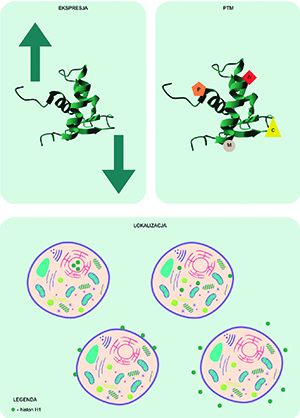Linker histones H1 in human disease
DOI:
https://doi.org/10.18388/pb.2021_561Abstract
Linker histones (H1) are basic proteins that are part of the nucleosome structure in the cell nucleus and are involved in the packaging of genetic material and the regulation of gene expression. As research progressed, it was discovered that linker histones constitute the largest group of histones in terms of variants found in humans. Even though the H1 variants differ slightly in the primary structure, they can perform different functions, undergo multiple post-translational modifications and differ in cellular localization. In addition to the nucleus, histones H1 can occur in the cytoplasm, on the cell surface and in the intercellular space. In these places, they play a supporting role for the immune system and act as signaling molecules. Changes in the levels of histones and their post-translational modifications have been associated with many human diseases and it is postulated that some of them may serve as biomarkers or therapeutic targets.

Published
Issue
Section
License
Copyright (c) 2024 Adrianna Żukowska, Joanna Perła-Kaján

This work is licensed under a Creative Commons Attribution 4.0 International License.
All journal contents are distributed under the Creative Commons Attribution-ShareAlike 4.0 International (CC BY-SA 4.0) license. Everybody may use the content following terms: Attribution — You must give appropriate credit, provide a link to the license, and indicate if changes were made, ShareAlike — If you remix, transform, or build upon the material, you must distribute your contributions under the same license as the original. There are no additional restrictions — You may not apply legal terms or technological measures that legally restrict others from doing anything the license permits.
Copyright for all published papers © stays with the authors.
Copyright for the journal: © Polish Biochemical Society.



